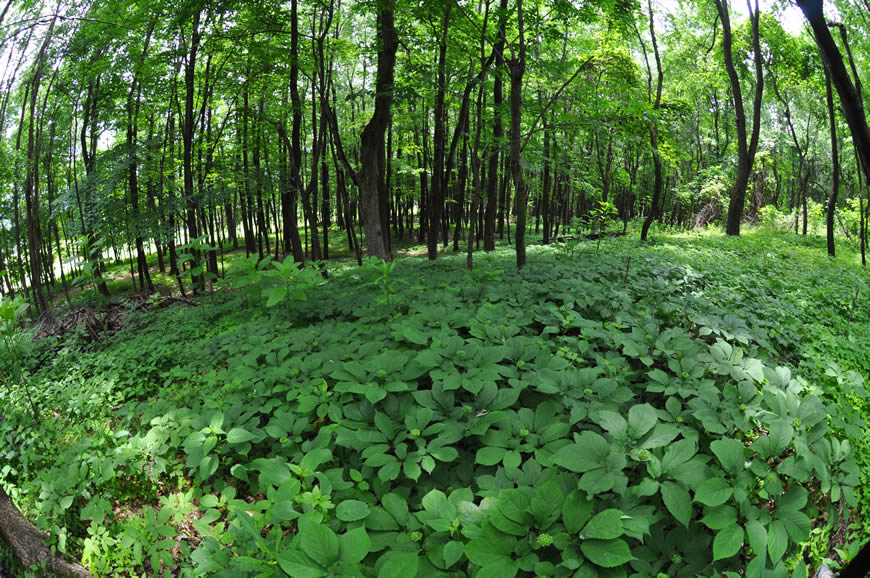Herbs have played a key role in human health with their beneficial effects and their use to treat various types of ailments or diseases has been around since ancient times. In most cultures they were often used in rituals due to their healing properties.
Ginseng is a deciduous (seasonally sheds leaves) perennial herbaceous plant that grows about 18 inches high and grows pretty prolifically in the mountains.
In traditional Chinese medicine, gensing has been used for more than 2000 years and many peoples, considered it a cure for all ailments.
In the 18th century it was also popular in America, especially when the native ginseng was discovered to be used by various Native American tribes. It is estimated that American colonists discovered it in the mid-1700s in New England.
“The history of human interaction with ginseng lurks in the language of the land. Look at a detailed map of almost any portion of the region and ginseng is registered somewhere, often in association with the deeper, moister places …”
“Seng Branch (Fayette County), Sang Camp Creek (Logan County), Ginseng (Wyoming County), Seng Creek (Boone County), Three-Prong Holler (Raleigh).”
“The hollows, deep dendritic fissures created over eons by water cutting through the ancient table land to form tributaries of the Coal River, receive water from lesser depressions that ripple the slopes.”
“These depressions are distinguished in local parlance as “coves” (shallower, amphitheater-shaped depressions), ‘swags’ (steeper depressions, ‘swagged’ on both sides), and ‘drains’ (natural channels through which water flows out of the swag or cove).”
“The prime locations for ginseng are found on the north-facing, ‘wet’ sides of these depressions. ‘Once in a while you’ll find some on the ridges, but not like in the swags there.’” (LOC)
Long before the 1700s, Native American groups such as the Iroquois had consumed American ginseng (garent-oguen) for indications ranging from fatigue and headache to infertility.
After French Jesuit Pierre Jartoux wrote in 1711 about environmental conditions under which ginseng flourished in temperate northeastern China, fellow Jesuit naturalist Joseph-Francois Lafitau, who was based in Canada, became inspired to search for ginseng in climatically similar New France.
After several months’ search in 1716, Lafitau successfully identified ginseng in the wilderness of North America, aided by the expertise of Mohawk women.
The findings he published inspired enterprising French merchants – and eventually their British counterparts in the Thirteen Colonies – to buy American ginseng from Native American harvesters and lucratively export it to Qing China, where it was immensely popular for its therapeutic properties but was overharvested and dwindling in supply. (Journal of Medical Humanities)
“The harvesting of ginseng (as well as other wild plants) flourished within a system of corn-woodland-pastureland farming. Crucial to this system was recourse to a vast, forested commons rising away from the settled hollows.”
“Because of the abundant supply of tree fodder (wild nuts and fruit), the central Appalachian plateau in the nineteenth century furnished some of the best pastureland in the country.”
“A seasonal round of plying the commons is registered in many of the names for swags and coves: Walnut Hollow, Paw-Paw Hollow, Beech Hollow, Red Root Hollow, Sugar Camp Hollow, and so forth.” (LOC)
Ginseng was the most important medicinal herb in their pharmacopeia Chinese cosmology framed medicinals from the vantage point of qi: the vital force that comprised and linked all entities, had complementary yin and yang elements, and whose elements’ disruption in humans could manifest as illnesses. (Journal of Medical Humanities)
American and East Asian ginseng are different.
Globalization accelerated the development and dissemination of medicines. The Empress of China’s journey occurred squarely between the late 1700s and early 1800s, when international trade facilitated much knowledge production worldwide.
The Empress of China set sail on February 22, 1784, less than a year after the Treaty of Paris was signed on September 3, 1783 (ending the American Revolutionary War), and several years before George Washington took office as America’s first president on April 30, 1789.
The Empress of China carried thirty tons of ginseng. It was Panax quinquefolius, the American ginseng native to specific temperate regions of North America and known to Chinese as xiyangshen, “west ocean ginseng”. (Journal of Medical Humanities)
Because xiyangshen was imported into China via the hot southern port of Guangzhou, it was assumed by Chinese to thrive in hot climates despite actually originating from temperate eastern North America.
The intimate integration of American ginseng into Chinese pharmacopoeia as xiyangshen supports two major points. First, that a millennia-old Chinese medical tradition assimilated a North American herbal as late as the 1700s testifies to Chinese medicine being dynamic, flexible, and continuously evolving, as opposed to static and rigid.
The herb was not quite as valued in America for its effects on the human body as it was in Qing China. The American ginseng root, known for its stimulant, therapeutic, and aphrodisiac properties was extremely popular in China.
After trading, the Empress of China arrived in New York Harbor on May 11, 1785 (22 months after her departure.) She carried 800 chests of tea, 20,000 pairs of nankeen trousers and a huge quantity of porcelain.
Newspapers announced her return, and stores up and down the East Coast sold her cargo. That’s where the Americans learned how to make real money in the China trade: the sale of Chinese export goods to Americans.
All told, the voyage earned a 25 percent return on investment. Investors had hoped for more, but they made enough to spawn a new era of commerce with China.
The Empress of China’s organizer gave a complete report of the voyage to John Jay, the U.S. foreign minister. Jay shared his findings with Congress. Members of Congress responded with ‘a peculiar satisfaction in the successful issue of this first effort of the citizens of America to establish a direct trade with China.’
For the next 60 years, the China trade would make New England merchants very, very wealthy. (New England Historical Society)




Leave your comment here: